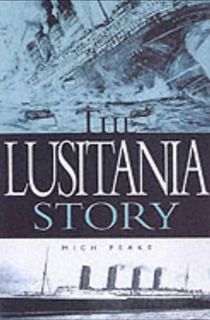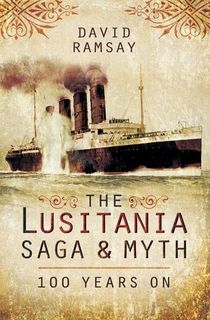Headlines were made when the RMS Lusitania was launched by the Cunard Shipping Line in 1906. The influential Lloyd’s List described the British-owned luxury ocean liner as “the greatest ship the world has ever known.” Just nine years later, with Britain now at war, the ship was in the news again for all the wrong reasons. In May 1915, whilst on a transatlantic crossing, the Lusitania was sunk by a torpedo from a German U-boat with the loss of many civilian lives.
Related: A Research Team Has Found the Endurance Shipwreck
Founded in 1840, Cunard Line had long enjoyed a reputation as one of the market leaders in the shipping industry. For many years Cunard’s ships held the prestigious Blue Riband, an accolade given to the passenger liner achieving the fastest Atlantic crossing. However, by the early years of the 20th century, Cunard was facing increased competition from its German and American rivals, and its record-breaking run as the Atlantic’s fastest passenger service came to an end.
This was considered such a blow to British prestige that the government offered to subsidize the construction of two new Cunard vessels, the Lusitania and Mauretania, with a view to regaining the Blue Riband. Both ships did go on to achieve record-breaking Atlantic crossings. However, the government funding came with a significant proviso, namely that in time of war the ships would be made available for military service.
Related: 7 Stunning Underwater Shipwrecks That Turn Back the Tides of Time
It came as no surprise, therefore, when, following the outbreak of World War I in the summer of 1914, the Lusitania and Mauretania were added to the British Admiralty’s list of ships to be converted into armed merchant cruisers. However, steamships like the two Cunard luxury liners were highly expensive to run and enormous amounts of coal were required to keep them afloat. The Lusitania was not requisitioned for active service, but instead resumed its transatlantic crossings, albeit with passenger numbers much reduced from those of the pre-war days.

The Lusitania Story
In early 1915, a new threat to British merchant shipping emerged in the form of torpedoes from German submarines. Germany was intent on sabotaging the British war effort by targeting the merchant ships which transported essential supplies across the Atlantic Ocean. As a result, Germany declared the waters around the British Isles a war zone and, flying in the face of previous conventions regarding naval warfare, ceased the practice of warning civilian ships that an attack was imminent.

Lusitania's lounge and music room.
Photo Credit: WikipediaAs the RMS Lusitania prepared to depart New York for Liverpool in early May 1915, the Germany Embassy in Washington, D.C. published the following advertisement in many American newspapers,
“Travelers intending to embark on the Atlantic voyage are reminded that a state of war exists between Germany and her allies and Great Britain and her allies; that the zone of war includes the waters adjacent to the British Isles; that, in accordance with formal notice given by the Imperial German Government, vessels flying the flag of Great Britain or any of her allies are liable to destruction in those waters and that travelers sailing in the war zone on the ships of Great Britain or her allies do so at their own risk.”
Related: 7 Books About Disastrous Shipwrecks in History
Despite this stark warning, only a few passengers decided not to make the journey and the Lusitania left port with a total of 1,962 passengers and crew on board. The impressive ocean liner was considered too robust and well-equipped to be sunk by a torpedo. It also seemed inconceivable that Germany would risk antagonizing the then-neutral United States by targeting such a high-profile vessel, which was known to carry thousands of American passengers across the Atlantic each year.
On May 6th 1915, the Lusitania approached the south coast of Ireland and thus entered the waters which Germany had designated as a war zone. Life on the ship appears to have continued very much as normal for the passengers. A concert in aid of Seamen’s Charities went ahead as planned that evening, with the only indication of any increased threat coming when the Lusitania’s Captain, William Turner, made an announcement requesting passengers not to smoke on deck in case the light coming from their cigars made the vessel more visible to passing submarines.
The end came the following afternoon, about ten miles off the Old Head of Kinsale on the coast of County Cork. The Lusitania was spotted by a German submarine, SM U-20, which had been active in the area for several days. The U-boat’s commanding officer, Walther Schwieger, gave the order for one torpedo to be fired. No warning was given to the passenger ship and the Lusitania suffered a direct hit to her starboard side.
Related: A Night to Remember: The Tragic Story of the RMS Titanic
The great ocean liner sank in just 18 minutes. Some survivors reported that they had heard a second loud explosion soon after the first blast and, initially, U-20 was believed to have fired two torpedoes. However, later investigations established that only one torpedo had been fired.

The Lusitania Saga & Myth
It has therefore been suggested that the Lusitania was secretly carrying large quantities of munitions, which were detonated when the German torpedo hit the vessel, and this was the cause of the second explosion. The German authorities were themselves quick to justify the attack on these grounds, claiming that because the Lusitania was carrying ammunition, it made the vessel a legitimate target.
A total of 1,195 passengers and crew perished in the disaster, the majority of whom were British citizens. The death toll also included 128 American men, women and children.

A dive team prepares to explore the wreck of Lusitania, 1935.
Photo Credit: WikipediaThe incident provoked huge outrage on both sides of the Atlantic and, with anti-German sentiment running high, President Woodrow Wilson was placed under extreme pressure to enter the war against Germany. Then First Lord of the British Admiralty, Winston Churchill famously remarked that, “The poor babies who perished in the ocean struck a blow at German power more deadly than could have been achieved by the sacrifice of 100,000 men.”
However, President Wilson was wary of a kneejerk reaction to the tragedy. Instead, the initial US response was limited to a written demand for an apology and an assurance that the Germans ceased indiscriminate attacks on non-combatant vessels. American patience was further tested when, in August 1915, a German U-boat launched an attack on another ocean liner, the SS Arabic. A strongly worded statement was issued to the effect that unless Germany ceased attacks on passenger ships, the US would be compelled to sever diplomatic ties and enter the war. On this occasion the Germans did decide to comply, doubtlessly aware of the tactical advantage of keeping the Americans on the sidelines.
Related: That Time Two Luxurious Ocean Liners Fought an Intense Naval Battle
In early 1917, German leader Kaiser Wilhelm II was persuaded by his military advisors to resume the indiscriminate attacks on shipping by German submarines. Calls for the United States to enter the war intensified and, in April of that year, Congress voted in favor of declaring war on Germany.
The United States’ entry into World War I did not take place until nearly two years after the sinking of the RMS Lusitania, but some recruitment posters urged Americans to “Remember the Lusitania!” As Churchill had predicted, the shocking event fueled anti-German sentiment to such an extent that, in the end, Woodrow Wilson’s previously resolute stance of neutrality became untenable. When the Lusitania was targeted by U-20 on that fateful afternoon in May 1915, it represented a significant moment in the eventual outcome of World War I.
Sources: History.com, Imperial War Museums
